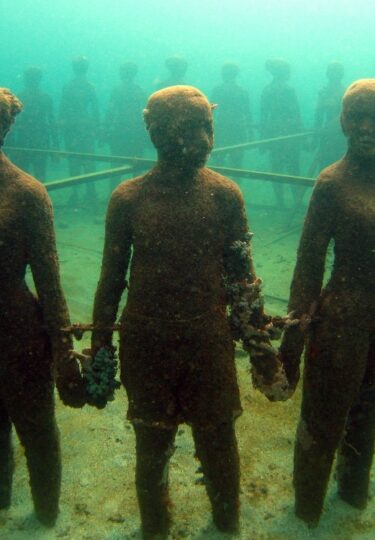Once you learn to snorkel or dive, a whole new world opens up underneath the surface. Corals, shoals of fish, and caves create a thrilling new experience.
Adding to that excitement are the artificial reefs and other attractions created by resorts for divers—and free-divers or snorkelers—to explore. Among the most haunting of these sites you can find under the sea are sculptures, some new, some ancient.
Seeing a work of art looming out of the mysterious depths is a unique experience. Here is where to find the world’s most fascinating underwater statues.
Molinere Underwater Sculpture Park, Grenada
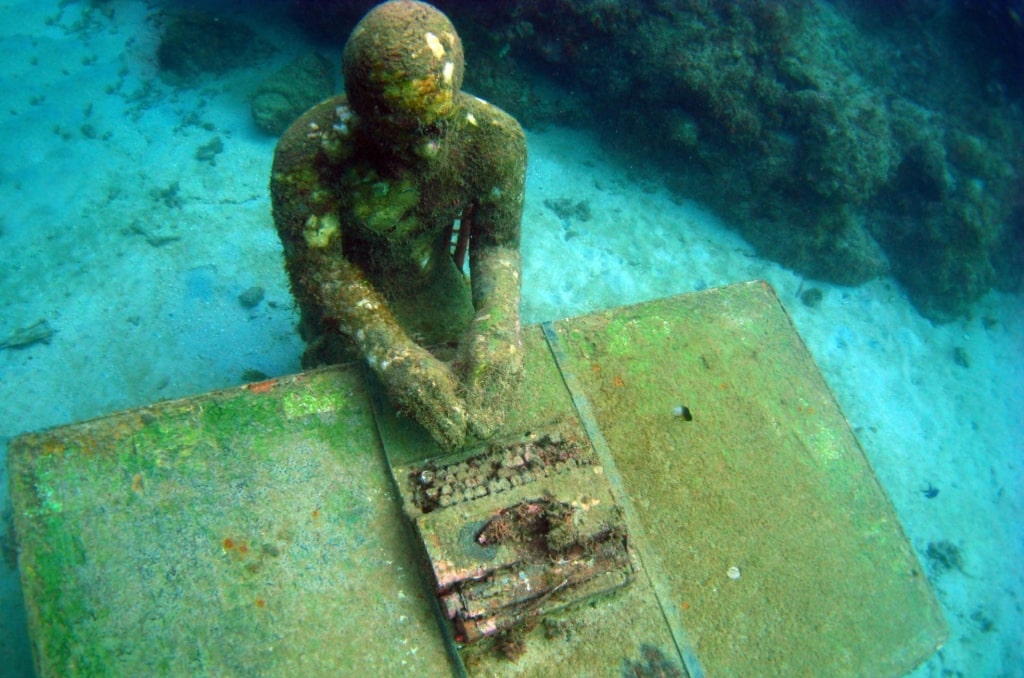
Molinere Underwater Sculpture Park, Grenada
Inside Molinere Beauséjour Marine Protected Area, underwater sculptor Jason deCaires Taylor and other local artists have created a series of amazing works. This was the world’s first public underwater sculpture park when it opened in Grenada in 2006.
A pH-neutral cement is the main material, allowing marine life to colonize its surface. Like any artificial reef, the statues ease environmental pressure by diverting activity from more natural reefs.
This is one of the best spots for scuba diving in the Caribbean, where the sculptures change with each passing season and year, becoming a living reef of their own. Each is different, based on local people or traditions of Grenada.

Molinere Underwater Sculpture Park, Grenada
“Man On A Bike” is exactly what it says: the surreal figure of a man cycling along the ocean floor. “TMACC Faces” is a rank of life-sized moldings from local college students, each different.

Molinere Underwater Sculpture Park, Grenada
One of the most photographed artworks is called “Vicissitudes”. This is a life-size cast of 26 children holding hands, a powerful emotional but strangely calm image.
All the sculptures are at depth from six to 15 feet, easily accessed by snorkelers as well as novice divers. With 75 in total so far, you’ll probably need more than one visit so you can see them all.
“Ocean Atlas”, Nassau, The Bahamas
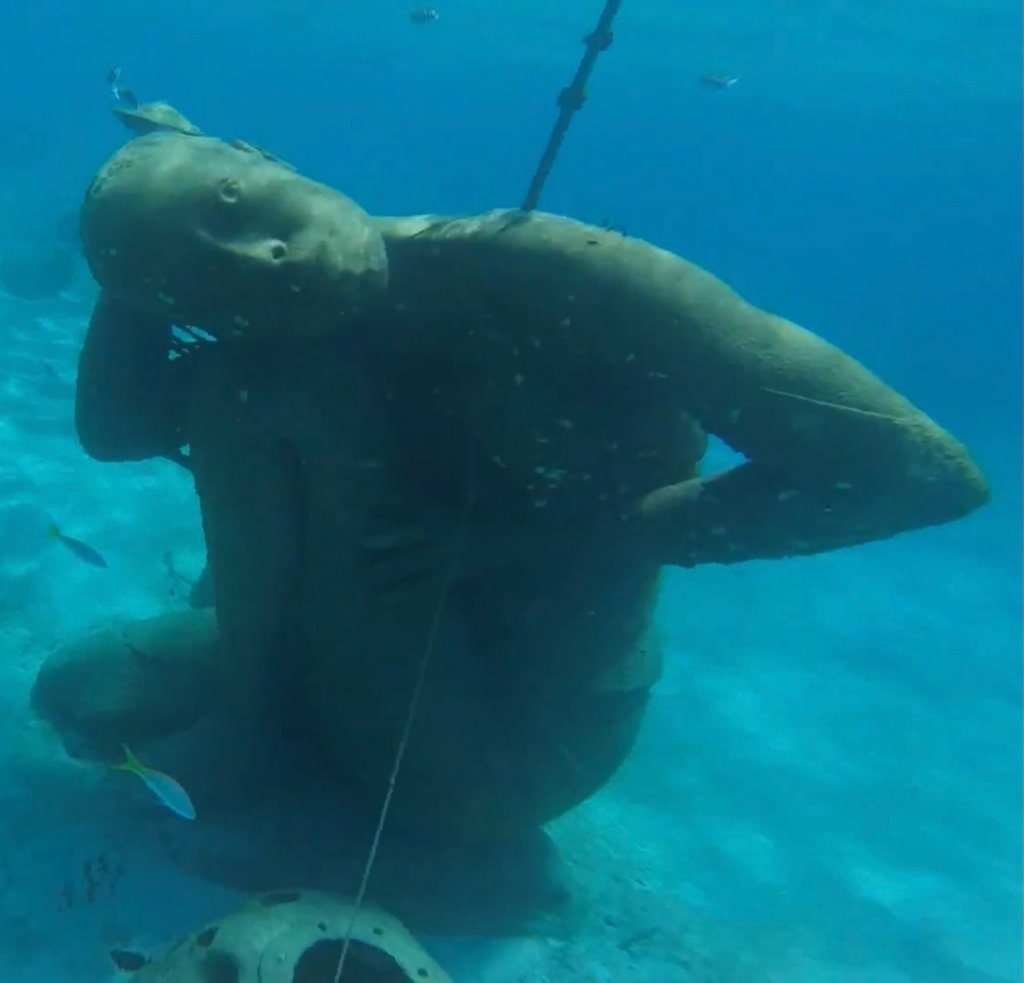
“Ocean Atlas”, Nassau, The Bahamas Photo by bowlochile on Wikimedia Commons, licensed under CC BY 3.0
After Grenada, Jason deCaires Taylor went on to work on the world’s largest underwater sculpture. Sunk into the sea off Nassau, in 2014, it stands 18 feet tall.
Called “Ocean Atlas”, the piece shows a young Bahamian woman (the model was a student called Camilla) carrying the ocean on her shoulders. It is designed to be only slightly submerged at low tide, so she is mirrored by the surface to create a powerful and fascinating image.
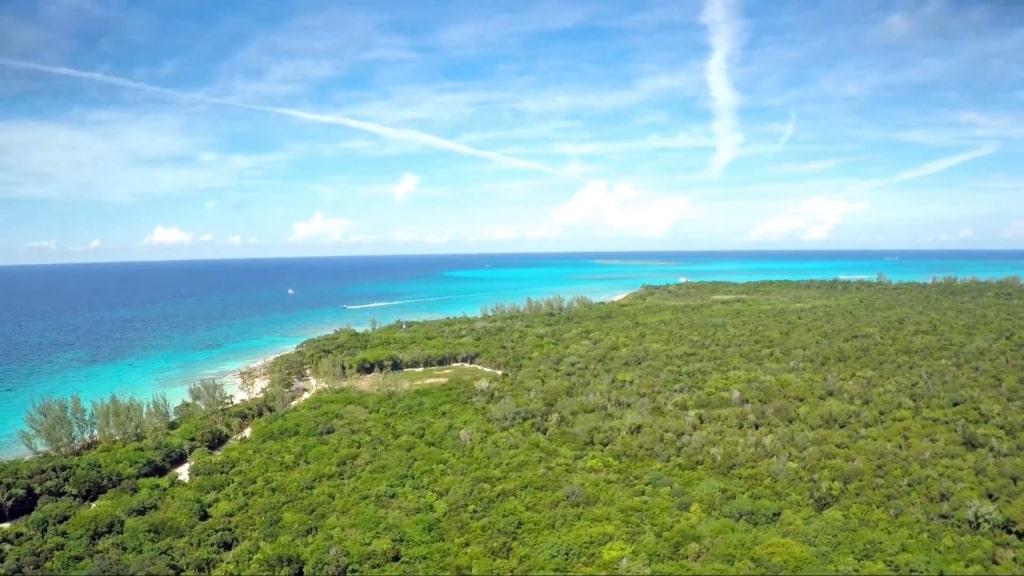
Clifton Heritage National Park Photo by Starklinson on Wikimedia Commons, licensed under CC BY 3.0
Commissioned by Bahamas Reef Environment Educational Foundation, the 60-ton piece stands in the Clifton Heritage National Park. Tours start on the shore, where snorkels and other equipment can be hired.
“Ocean Atlas” stands among smaller but no less striking works. “Lucayan Face”—a face emerging from the seabed— is by local artist Andret John.
Another local man, Willicey Tynes, created a piece called “Virtuoso Man”. This eight-foot-tall sculpture is of a kneeling man looking upward with a staff in hand.
Tynes was inspired to create the garden after seeing some of Jason Taylor’s work. It also features 50 round structures by US company Reef Ball, designed to attract underwater life.
“Christ of the Abyss”, San Fruttuoso, Italy
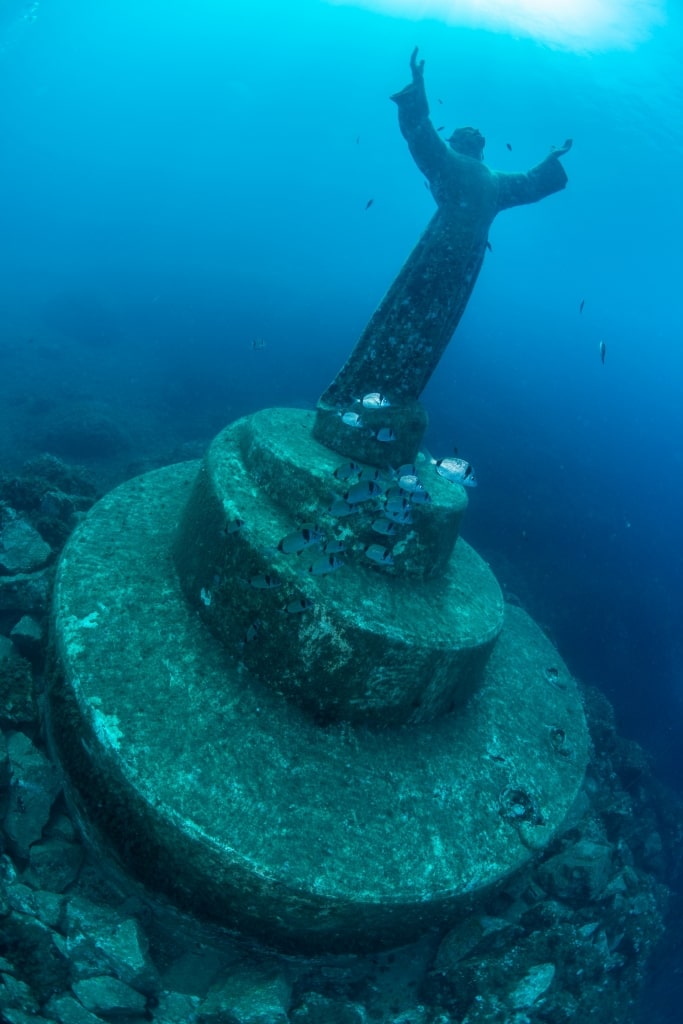
“Christ of the Abyss”, San Fruttuoso, Italy
This bronze sculpture, lying more than 50 feet deep, shows a figure of Christ with his arms outstretched. Standing eight feet tall, it is by sculptor Guido Galletti.
The fascinating underwater sculpture marks the spot where Dario Gonzatti, a pioneer in the use of scuba gear, drowned in 1947. His rebreather was developed from the models used so successfully by the Italian Navy during WWII.
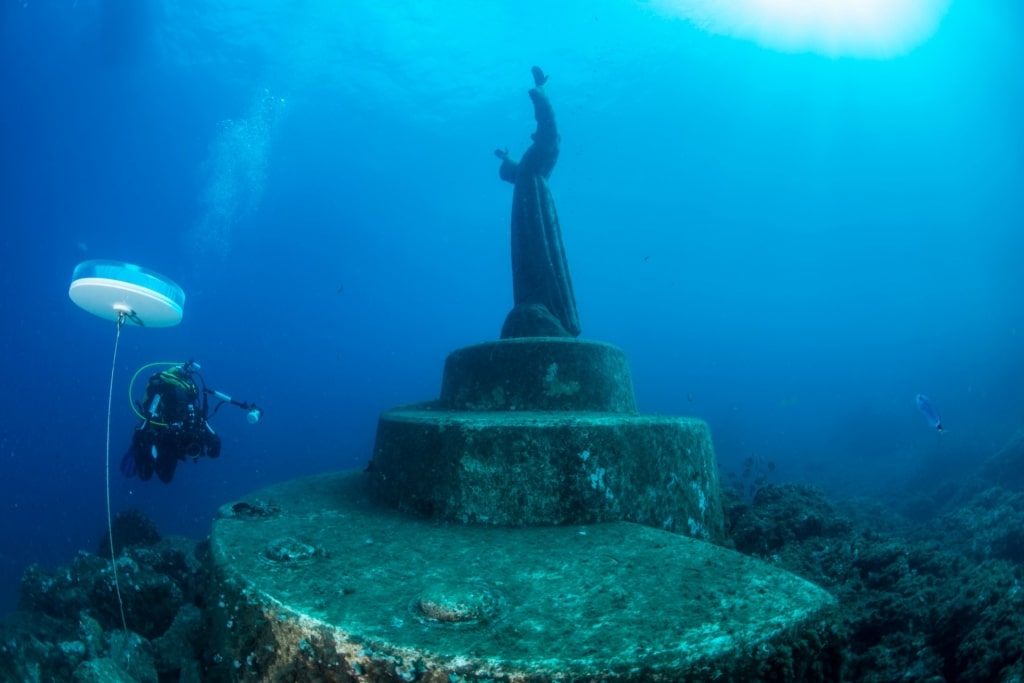
“Christ of the Abyss”, San Fruttuoso, Italy
The statue commemorates all who have died at sea and is made of bronze donated from all over the world. Medals of sailors lost at sea, bells, coins and even a submarine propeller from the US were all melted down to cast it.
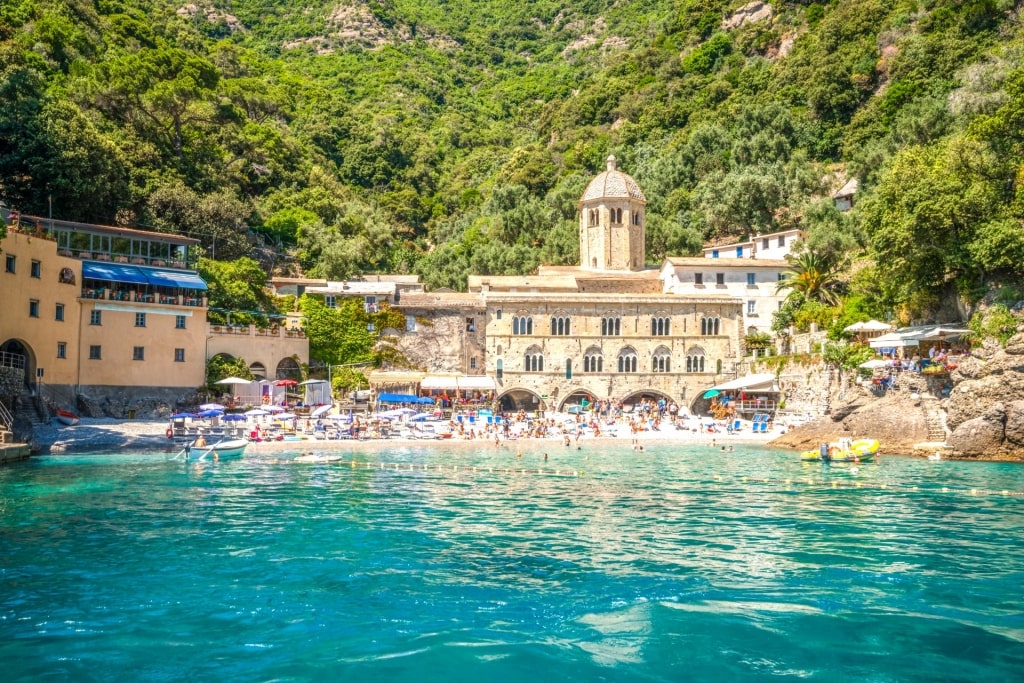
San Fruttuoso, Italy
You can find the “Christ of the Abyss” in the lovely bay of San Fruttuoso, a quiet place not far from Portofino dominated by a tenth-century Benedictine Abbey. Beside the monastery, which is open all year, stands a small replica of the statue.
Small boats will take you out to see the original, with glass bottoms to give you a view. Of course, divers and even snorkelers can take an even closer look.
Another exact replica, cast from the same mold, stands on the seabed off Key Largo, Florida. There is yet another copy off the coast of Grenada.
“Guardian of the Reef”, Grand Cayman
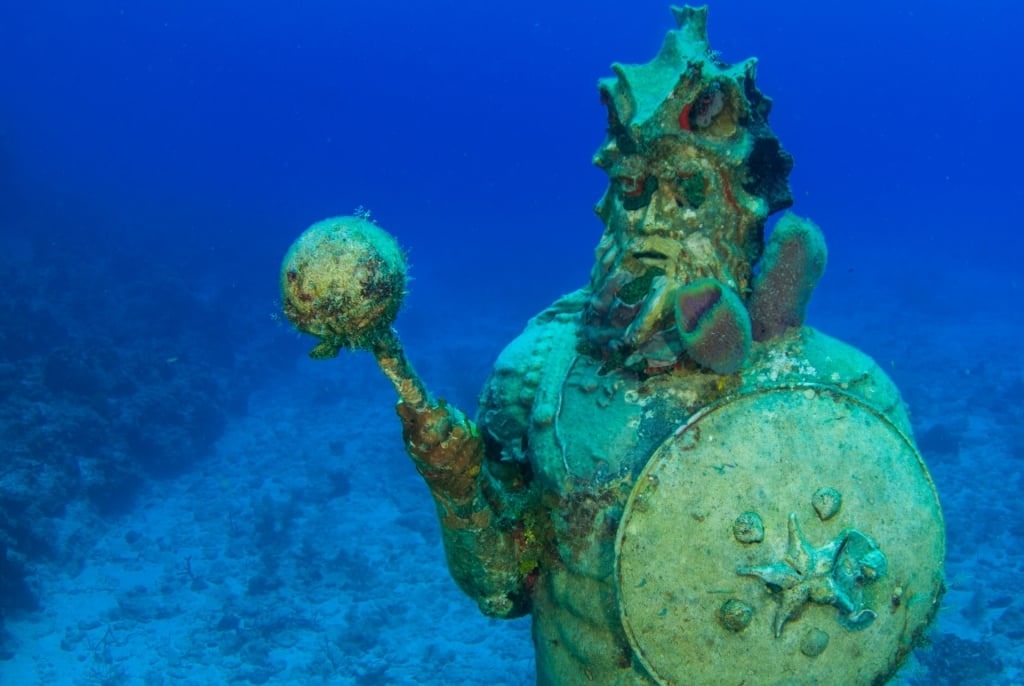
“Guardian of the Reef”, Grand Cayman
Anyone who has dived in the Cayman Islands will have heard of Nancy Easterbrook. Her company, Divetech, leads the island’s fight against invasive lionfish.
She also helped raise $750,000 for the USS Kittiwake, a former US Navy diving support vessel carefully scuttled off Grand Cayman for divers to explore. Another recent project is this impressive bronze statue near her dive shop on Grand Cayman.
The clear, warm waters of the Caribbean islands are a delight for divers, and attractions such as this add interest to any underwater excursion. The statue is a half Greco-Roman warrior, half seahorse figure by Canadian artist Simon Morris.
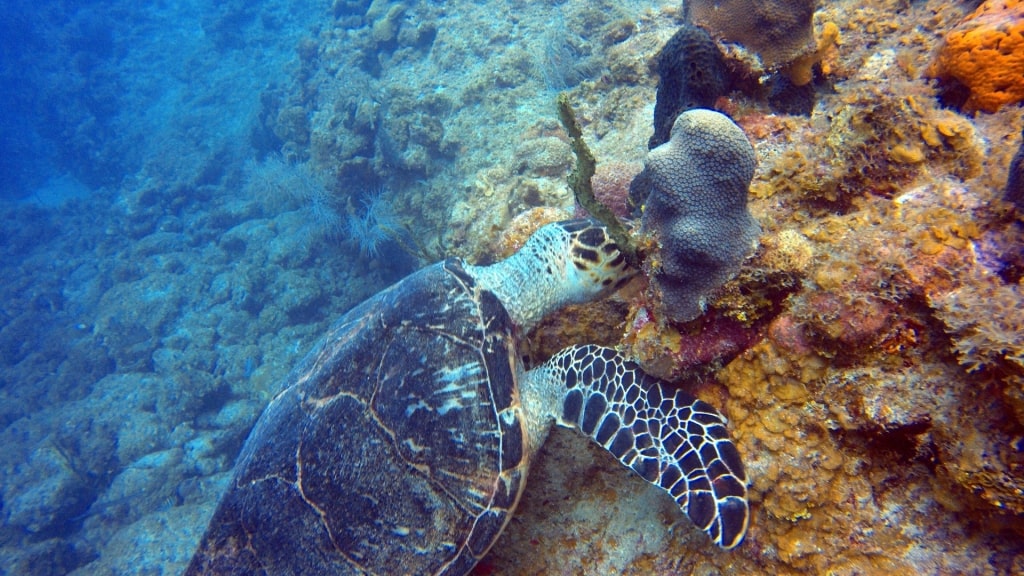
Lighthouse Point
Looking like something from mythology, it was sunk at a 65 feet depth off the island’s Lighthouse Point. Standing on a four-foot plinth, the whole is around 17 feet high.
Another sculpture by Simon Morris of a mermaid stands in the famed dive waters of the island’s Sunset Reef. Named for Amphitrite, the wife of Poseidon, it is a copy of one in British Columbia.
“The Guardians”, Talamone, Italy
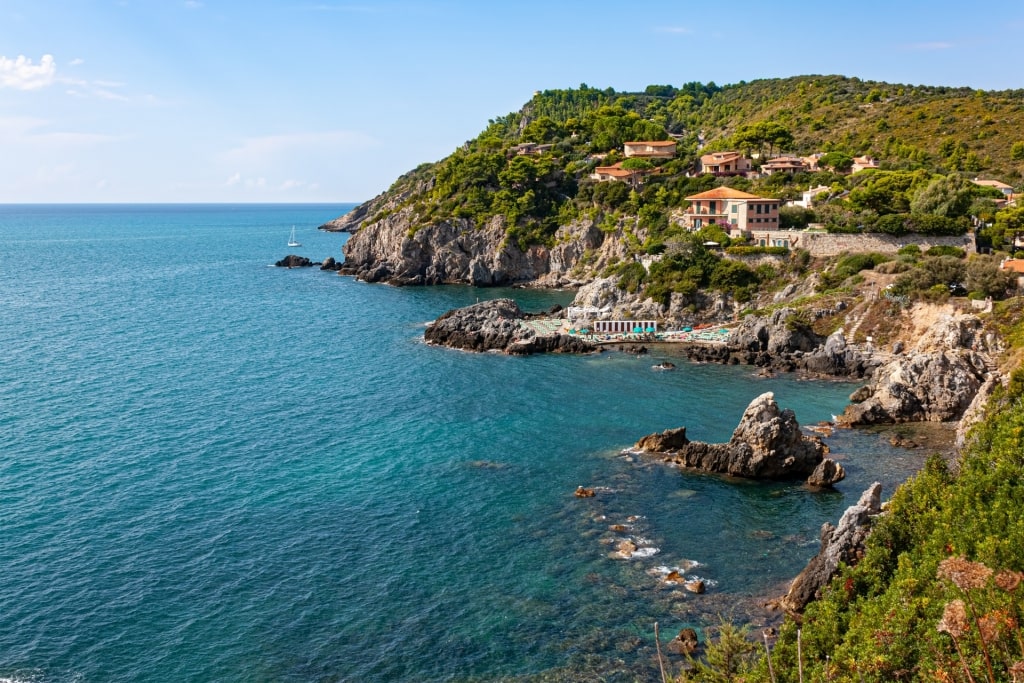
Talamone, Italy
Italian fisherman Paolo Fanciulli was the driving force behind an unusual underwater sculpture park in the water off Talamone. This small village in Tuscany is about an hour from Civitavecchia, the port of Rome.
Fanciulli created the park with the idea of dropping rocks on the seabed to stop illegal trawlers. Their nets were wiping out an entire ecosystem inside the protected coastal zone.
Rather than using concrete blocks, he asked the famous marble quarries at Carrara—the same ones used by Michelangelo—if they could help. They offered him 100 blocks, and a number of artists seized the chance to help a worthy cause.
British artist Emily Young created four massive “guardians”, each weighing 12 tons. A fault line in one block became the “teardrop” of her “Weeping Guardian”.
Giorgio Butini’s “Siren” and “Acqua” are among other haunting works on the seabed. A mermaid by artist Aurora Vantaggiato is equally beautiful.
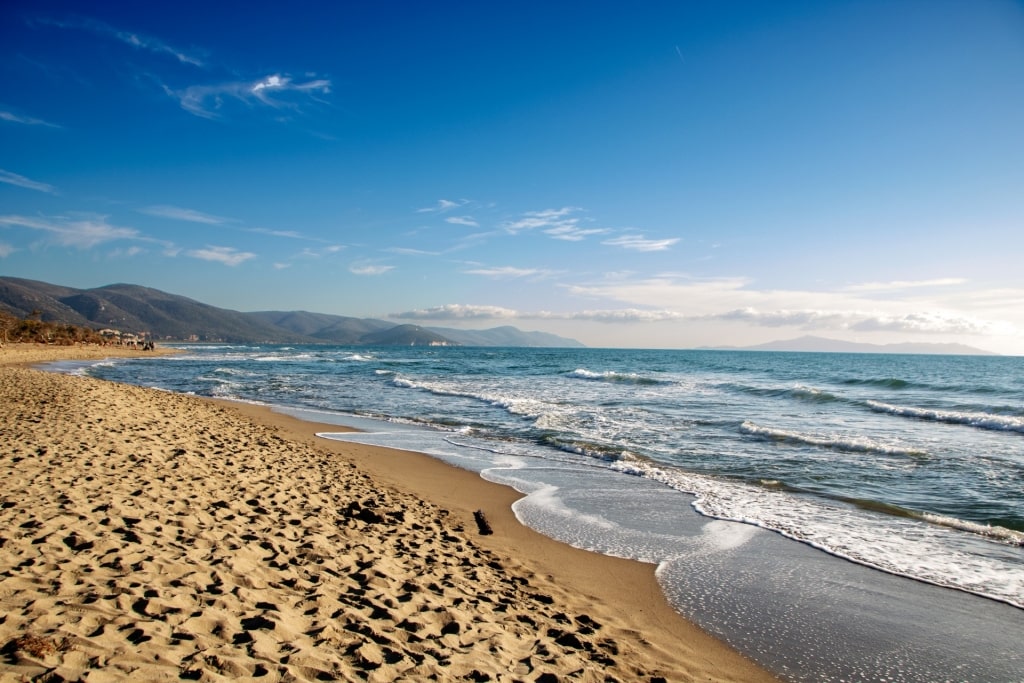
Maremma/Ucellina Natural Park, Talamone, Italy
Even better, the blocks are also achieving their objective. Trawling has stopped and dolphins have found refuge among the sculptures, adding a marine dimension to the beautiful Maremma/Ucellina Natural Park on shore.
In all, there are 39 sculptures, with plans for a total of 60 as funds allow. You can take a guided scuba tour of the large site or just explore on your own.
Museo Subacuático de Arte (MUSA), Cancún, México

Museo Subacuático de Arte (MUSA), Cancún, México
A child with a football under their arm. A group of businessmen with their heads buried in the sand. These are just two of the statues you’ll find in the waters off Cancún.
In total, there are more than 500 life-size statues in this still-growing Underwater Museum of Art, making it one of the best diving spots in the world. Jason deCaires Taylor was once again the artist behind the ambitious project, which aims for 1,200 pieces.

Museo Subacuático de Arte (MUSA), Cancún, México
The “gallery” of fascinating works in concrete now includes such sights as a VW Beetle and a set of giant hands. All are designed to create an artificial reef and protect the existing ones.
Taylor’s vision for the park has been brought to life with the help of a small group of other sculptors. One of the most striking recent pieces is an elephant by Roberto Díaz Abraham.
All the works use rough concrete that allows marine life to gain a hold. Installation of each piece is also synchronized with coral spawning times to encourage growth.

Glass-bottom boat tour in Cancún, México
Sites at different depths are optimized for visits by snorkeling, diving or glass-bottom boat. On land, Cancun’s Plaza Kukulcan visitor center shows dozens of replicas.
Museo Atlántico, Lanzarote, Canary Islands

Museo Atlántico, Lanzarote, Canary Islands
The first underwater museum in the Atlantic opened off Lanzarote’s Playa Blanca in 2016. Once again, eco-artist Jason deCaires Taylor was the inspiration for the sunken art.
Striking pieces made from life-casts include “Los Jolateros”, a group of children in boats. “Rubicon” shows ten people walking towards a wall.
You can see a sculpture of someone taking a selfie, and a businessman playing on a swing. The largest work has 200 men and women lying intertwined in a circle on the seabed.
The most poignant is “The Raft of Lampedusa” which shows 13 men, women and children in a dinghy. Inspired by Géricault’s “The Raft of the Medusa”, it is a reminder of the Mediterranean’s refugee crisis.

Museo Atlántico, Lanzarote, Canary Islands
The sculptures are at around 30 feet deep and diving here, despite it being the Atlantic, is year-round. All equipment can be hired at the park if you do want to visit.
Tours permit access for certified divers, with refresher or beginner options for those with little or no prior experience. Snorkelers can also visit and glass-bottomed boats allow visits by anyone who prefers to stay dry.
Head of Caesarion, Alexandria, Egypt

Lost City Of Atlantis, Egypt
Was it Cleopatra’s Palace, or perhaps the origin of tales about a Lost City Of Atlantis? The sunken port of Heracleion, 20 miles east of Alexandria, is beginning to give up its treasures, if not its secrets.
These 2,000-year-old ruins fell into the sea during an ancient earthquake in the second century BC. They were only discovered in 1998 by marine archaeologist Franck Goddio.
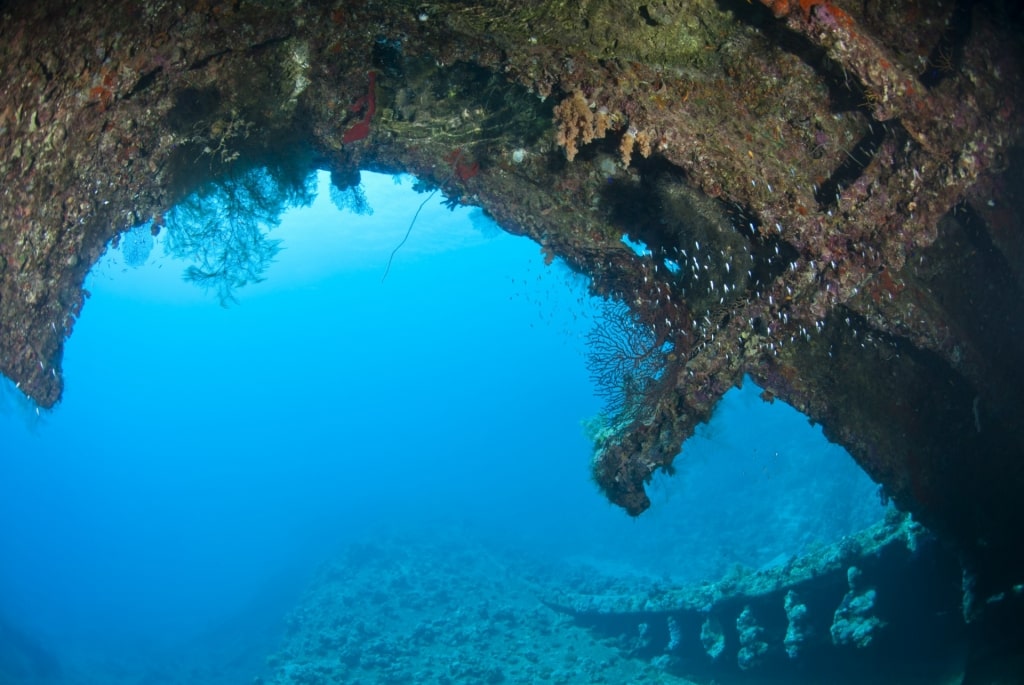
Lost City Of Atlantis, Egypt
A temple dedicated to the god Amun-Gereb was one of the many ancient buildings under the surface. There were also the remains of 64 ships, hundreds of anchors, and piles of gold coins.
The many statues that once decorated its public buildings include a granite Sphinx representing Cleopatra’s father, and guarding a temple. Most dramatic is the massive stone head of Caesarion, Cleopatra’s son with her lover Julius Caesar–one of the most fascinating underwater statues you can imagine.
The majority of the remains are too delicate or too large to move off the seabed. Murky waters make diving a challenge, so there are plans to build an underwater museum on the site allowing access in transparent tunnels.
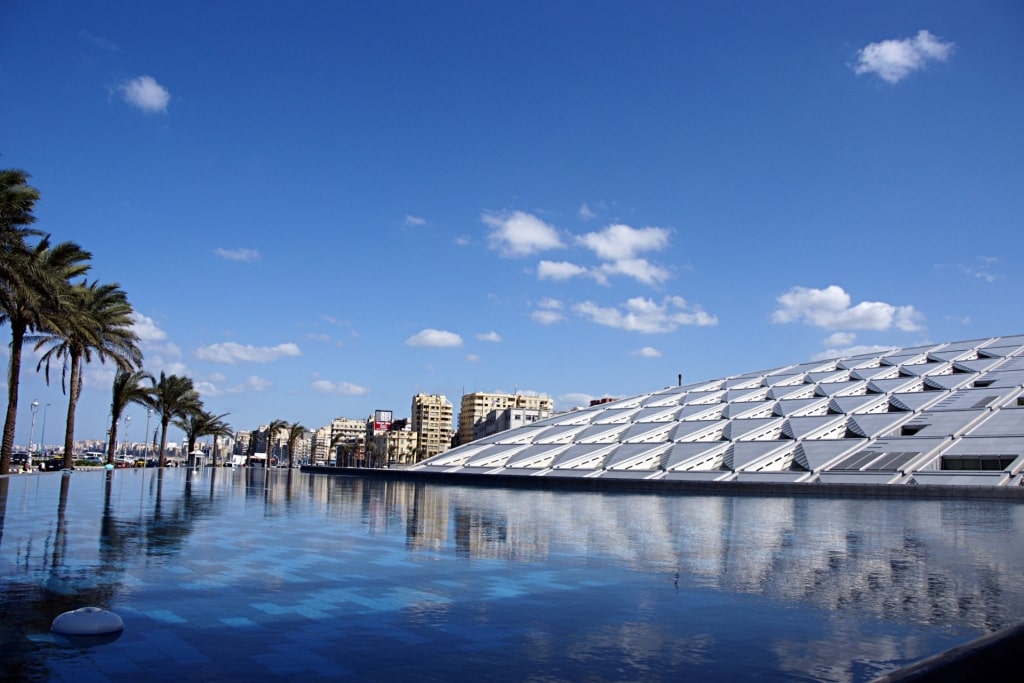
Bibliotheca Alexandrina in Alexandria, Egypt
In the meantime, some of the finer statues can be seen in Alexandria’s Bibliotheca Alexandrina. Its multilingual Antiquities Museum has a gallery displaying that colossal Caesarion head and a wonderful statue of the Egyptian god Isis, among many other fascinating underwater finds.
Read: Best Things to Do in Alexandria, Egypt
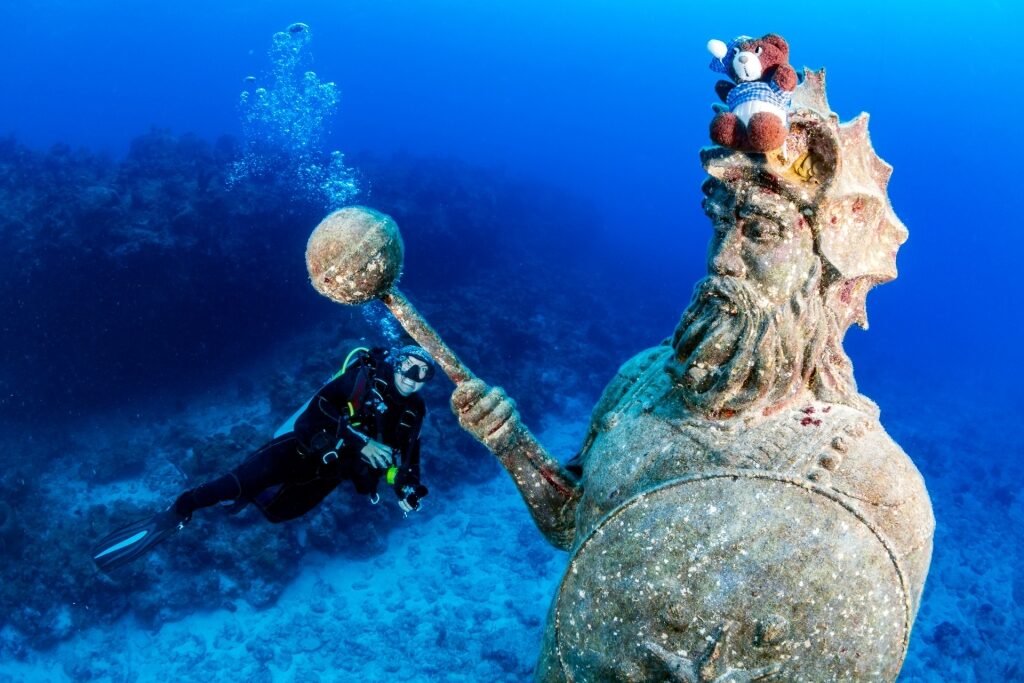
Underwater Museum of Cannes, France
In 2021, artist Jason deCaires Taylor brought his underwater vision to the Mediterranean. The city of Cannes opened this first underwater eco-museum in France in an area reserved for swimmers.
Six residents of Cannes served as models for a series of masks that were dropped into shallow waters near the island of Sainte-Marguerite. The inspiration was the “Man in the Iron Mask”, now famous in literature and on screen, who was imprisoned on the island in the 1690s.
The mask theme is also a tribute to the place of Cannes in the world of the arts, specifically film. The models range from a seven-year-old girl to a 78-year-old fisherman.
Each mask is about six feet tall and weighs around ten tons. At a maximum depth of 15 feet, they can be seen by snorkelers and freedivers.
With boats banned, and clean water, the site is a haven for marine flora and fauna. Access is free to all and there is regular environmental monitoring.
The artwork stands in an area of seagrass meadows that had suffered degradation from boat anchors and fishing. Restoring this marine Posidonia grass is vital to the health of our oceans because of the large amounts of oxygen it produces.
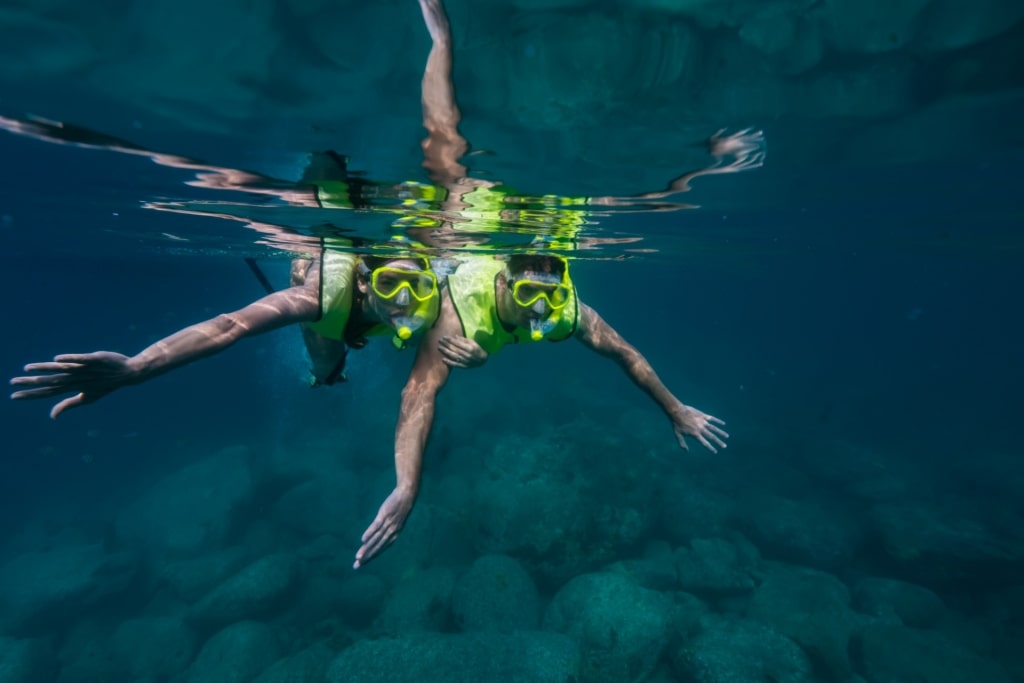
Inspired by these treasures to visit some amazing destinations? Take the plunge by browsing our worldwide cruise itineraries and find the cruise that’s just right for you.
